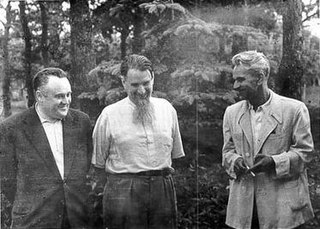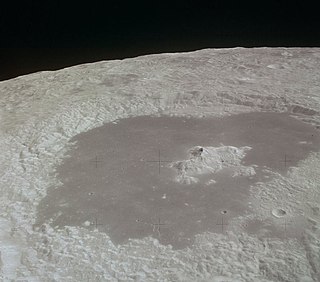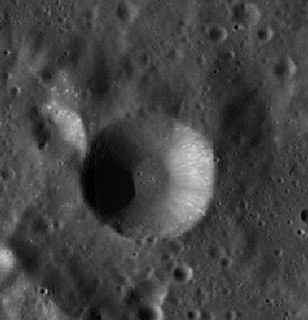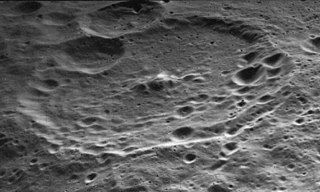- Zu Chong-Zhi is also the name of asteroid 1964 VO1; see also 1888 Zu Chong-Zhi.
 Oblique Apollo 16 image, facing east | |
| Coordinates | 17°18′S145°06′E / 17.3°S 145.1°E Coordinates: 17°18′S145°06′E / 17.3°S 145.1°E |
|---|---|
| Diameter | 28 km |
| Depth | Unknown |
| Colongitude | 215° at sunrise |
| Eponym | Zu Chongzhi |
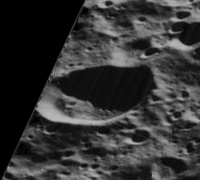
Tsu Chung-Chi is a relatively small lunar impact crater on the Moon's far side. It lies to the west-southwest of the crater Leonov, and to the northeast of the large walled plain Mendeleev. To the north of Tsu Chung-Chi is the Mare Moscoviense, one of the few maria on the Moon's far side.

Lunar craters are impact craters on Earth's Moon. The Moon's surface has many craters, almost all of which were formed by impacts.

An impact crater is an approximately circular depression in the surface of a planet, moon, or other solid body in the Solar System or elsewhere, formed by the hypervelocity impact of a smaller body. In contrast to volcanic craters, which result from explosion or internal collapse, impact craters typically have raised rims and floors that are lower in elevation than the surrounding terrain. Impact craters range from small, simple, bowl-shaped depressions to large, complex, multi-ringed impact basins. Meteor Crater is a well-known example of a small impact crater on Earth.

Earth's Moon is an astronomical body that orbits the planet and acts as its only permanent natural satellite. It is the fifth-largest satellite in the Solar System, and the largest among planetary satellites relative to the size of the planet that it orbits. The Moon is, after Jupiter's satellite Io, the second-densest satellite in the Solar System among those whose densities are known.
This is a bowl-shaped crater formation that is slightly elongated to the northwest. It has undergone some erosion, with a small, cup-shaped crater intruding slightly into the southern rim and several tiny craterlets within the interior. The inner walls are simple slopes down to the interior floor. This crater is otherwise undistinguished.
This feature - one of the about 500 features identified on the photographs of the far side of the Moon made by Luna 3 in 1959 - was named after the Chinese mathematician and astronomer Zu Chongzhi. According to the memoirs of Boris Chertok, who was closely involved with the Luna 3 mission, some fairly complicated politics was involved in picking the name:

Luna 3, or E-2A No.1 was a Soviet spacecraft launched in 1959 as part of the Luna programme. It was the first-ever mission to photograph the far side of the Moon and the third Soviet space probe to be sent to the neighborhood of the Moon. Though it returned rather poor pictures by later standards, the historic, never-before-seen views of the far side of the Moon caused excitement and interest when they were published around the world, and a tentative Atlas of the Far Side of the Moon was created after image processing improved the pictures.
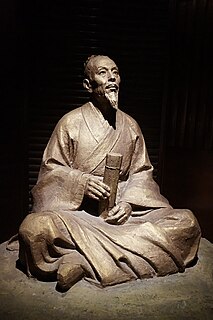
Zu Chongzhi, courtesy name Wenyuan, was a Chinese astronomer, mathematician, politician, inventor, and writer during the Liu Song and Southern Qi dynasties. He was most notable for calculating pi as between 3.1415926 and 3.1415927, a record which would not be surpassed for 800 years.

Boris Evseyevich Chertok was a Russian electrical engineer and the control systems designer in the Soviet Union's space program, and later the Roscosmos in Russia.
Finally, the Keldysh Commission received a go-ahead, and obtained a decision of the Praesidium of the Academy to name the craters after prominent scientists and cultural figures: Giordano Bruno, Jules Verne, Hertz, Kurchatov, Lobachevsky, Maxwell, Mendeleev, Pasteur, Popov, Skłodowska-Curie, Zu Chongzhi and Edison.
Mstislav Vsevolodovich Keldysh was a Soviet scientist in the field of mathematics and mechanics, academician of the USSR Academy of Sciences (1946), President of the USSR Academy of Sciences (1961–1975), three times Hero of Socialist Labor, fellow of the Royal Society of Edinburgh (1968). He was one of the key figures behind Soviet space program. Among scientific circles of USSR Keldysh was known with epithet "the Chief Theoretician" in analogy with epithet "the Chief Designer" used for Sergey Korolyov.
Alexander Stepanovich Popov was a Russian physicist, who was one of the first persons to invent a radio receiving device.
Sklodowska (Skłodowska) is a large lunar impact crater that is located on the far side of the Moon. It lies just past the southeastern limb, and can sometimes be viewed from Earth under favorable conditions of libration and illumination. The crater is located to the northeast of the older walled plain Curie, and to the southwest of Pasteur, another walled plain.
As reported by "reliable sources", the most controversial figure was Zu Chongzhi. This 5th-century mathematician was said to be famous in China, but none of my mathematician friends was able to explain what he was famous for. But we could not offend China, a great and friendly country. Central Committee's instructions demanded that the list included an American and a Chinese. It was easy to pick an American - everyone was fine with Edison. But concerning the Chinese, I was told that we had to consult with the embassy, which, in its turn, sent a request to Beijing. [1]
